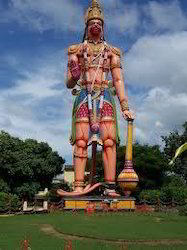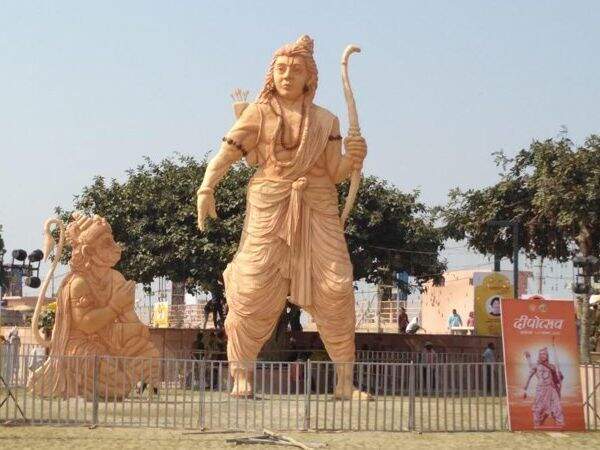By Stephen David (For Religion Unplugged)
(ANALYSIS) In October 2018, Indian Prime Minister Narendra Modi unveiled the world’s tallest statue, a nearly 600-foot-tall concrete and bronze figure of Indian independence leader Sardar Vallabhbhai Patel, in the hero’s native state of Gujarat (which is also Modi’s home state).

The Statue of Unity is four times the height of the Statue of Liberty, nearly 60 stories high, and beat the Spring Temple Buddha statue in China by almost 100 feet for the world record title. It’s become a major tourist site, a sort of nationalist pilgrimage. But now, several Indian states are vying to outdo Gujarat and beat China for the highest number of the world’s tallest religious statues.
The statues are the most visible symbols of how Modi’s Bharatiya Janata Party (BJP) is fulfilling campaign promises since 2014 to make India a Hindu nation, despite criticism of the government for intolerance of religious minorities, particularly Muslims and Christians.
Elevating Lord Ram
Just a few miles from the new Lord Ram temple complex in Ayodhya, Uttar Pradesh, a ground breaking ceremony was held on Aug 5, 2020, the one-year mark of the Indian government’s revocation of Kashmir’s autonomous rule that had been granted in the constitution.
Kashmir is India’s only Muslim-majority region, disputed with Pakistan, and Modi’s BJP campaigned on the promise to open up Kashmir to Hindu settlement. With the Supreme Court’s ruling in favor, the Ram temple is being constructed on the ruins of a 16th century mosque, destroyed by a Hindu mob in 1992 whose riots killed thousands of Indians, mostly Muslims.
There in the temple complex, 400 miles east of the capital New Delhi, state government authorities are preparing to erect a 750-foot-high statue of the Hindu god Ram on the banks of the Saryu river. The government envisions this concrete structure as part of its Ram temple tourism attraction that is expected to draw millions of tourists from around the world every year.
The Taj Mahal, a Muslim burial tomb, is in the same state and sees about 7-8 million visitors a year normally, with 800,000 from outside India, but the state government removed the tourist attraction from its marketing.

The Ram statue is to be erected on a 100-acre lot along the Lucknow-Gorakhpur highway. The state government has a sculptor’s model ready: it shows Ram with a bow in one hand and a string in the other, standing on a 162-foot-high base.
The entire project is estimated to cost more than $450 million (USD), much of it to be raised from Ram devotees and donations from the private sector. The statue is part of the plans to redevelop Ayodhya. The Ram Nagari Ayodhya project includes a state-of-the-art digital museum, interpretation center, food plaza, library and other facilities catering to both pilgrims and tourists.
A striking feature of this Ram statue will be a 65-foot overhead umbrella. It is expected to be taller than the existing Statue of Unity in Gujarat and the planned Shiv Smarak statue off the Bombay coast.
The UP state government has set aside almost $50 million for the preliminary work for this project, which the UP government hopes to complete just before it gets ready for the next local level assembly elections. UP’s ruling Hindu nationalist BJP government, Modi’s party, is headed by a temple priest-turned-politician, Yogi Adityanath, who helped the BJP win 312 seats in the 403-member state house.
A die-hard Ram devotee, Adityanath is driven to make sure both the Ram temple and the colossal statue are completed soon. A founder of the Hindu Yuva Vahini (Hindi Youth Force), he is hoping the Ram projects will increase the BJP’s number of seats in the 2022 assembly vote.
In 2017, Adityanath announced his plans to erect the statue of Ram to go along with the grand temple that is expected to be ready in 2023, just a year before the national elections, in which Modi will shoot for a third term as prime minister.Ram is a powerful symbol of Hindu strength that Modi will leverage to extend his BJP party’s reach even further. From 282 of 545 seats in parliament in 2014 to 312 in 2019, the strength of the BJP has continued to grow.
The party’s leadership is banking on the Ram factor to push their numbers even more in the 2024 national elections. The party promised to build this temple in its sankalp patra, the party manifesto, as part of its long-range plans to transform India into a Hindu nation, despite the country’s secular constitution.
Bombay’s statue of a Hindu warrior king
Then there are the plans for a statue of a Hindu warrior king.On a 15-acre lot in the Arabian Sea, off the coast of the Indian commercial capital of Bombay, the local government is working on an ambitious plan called Shiv Smarak : a colossal, almost 700-foot-high concrete statue of King Chhatrapathi Shivaji Maharaj, a Hindu warrior who formed the Maratha empire by fighting off Muslim Mughals.
The Shiv Smarak will be situated one mile out to sea on a man-made island of rocks, across from Bombay’s Chowpatty beach. The island complex will feature an elaborate garden, a library, a 10,000-seat convention hall and a food court. In December 2016 itself, a jal pujan, a religious ritual, was performed on the island to set this project in motion.Popularly called Shivaji, the king rose to royal power from humble beginnings as a farm boy, an inspirational tale that has spawned a huge following.
Shivaji was also the founder of the Maratha empire, whose Hindu kings fended off the might of the Muslim Mughal emperors in India some 300 years ago. The political party Shiv Sena, which is very popular in Bombay, has always lionized Shivaji.
Maharashtra State’s Chief Minister Udhav Thackeray’s father, the late Bal Thackeray, was a powerful Shiv Sena party boss in Bombay, who fiercely defended Modi when the latter was chief minister of Gujarat from 2001-2014 before becoming prime minister.
Some senior party leaders had called for Modi’s head in the wake of the 2002 communal riots in Gujarat that killed hundreds of people, most of them Muslims.The powerful Shiv Sena political party that is in power in Maharashtra draws its inspiration from Shivaji, its ideological mentor. Shivaji’s mother Jijabai had a powerful influence on him.
She was from a high-ranking caste, the Yadavas, who believed they were descendants of the Hindu god Krishna.Noted educator and writer KE Radhakrishna told Religion Unplugged that “the race for colossal statues is not a good sign as our Hindu scriptures and teachings don’t encourage such colossal spending on statues… this is more a demonstration of political one-upmanship than real religious devotion.”Professor Radhakrishna added that “Ayodhya— Hindus believe Ram was born in this city— means ‘a place that cannot be conquered’ and that which cannot be conquered is a metaphor not only denoting a city but an attitude.
Ayodhya stands for harmony and forgiveness and building a big structure doesn’t reflect true Ramaism.” Ram devotees, however, are not complaining. For the state and the federal government, supporting these colossal projects is also about generating tourism income.
Hanuman statue in the south
In the south Indian state of Karnataka, home to India’s Silicon Valley, Bangalore, and a NASA-style space center, a private trust wants to finance the construction of a 213-foot copper statue of Ram’s faithful devotee, the monkey god Hanuman, close to the UNESCO world heritage site of Hampi in central Karnataka. Karnataka State, currently headed by a BJP government, has a link to Ram too: the epic Ramayana’s Kishkinda, the kingdom of Vanara King Sugriva, is believed to be near Hampi, the former capital of the 15th century Vijayanagar empire, one of India’s greatest Hindu empires.

The federal government is embarking on a major Ram pilgrimage circuit in the country and Kishkinda will be connected to this circuit; it will also add two more destinations—the Mahabaleshwar temple in Gokarna and the Chandradrona hill range in Chikmagalur.
Hampi is also home to the Anjanadri hill, regarded as the birthplace of Hanuman. A private trust formed in February 2020 to oversee the Hanuman statue project and plans to produce a 705-foot statue. The project has brought in as its key advisor a senior official from the north Indian temple town of Dwarka, one of the key players in getting the new Ram temple project in Ayodhya up and running.About 100 miles north of Bangalore is the Jain pilgrimage center of Sravanabelagola, where a 55-foot statue of Gomatesvara Bahubuli, a much revered figure in the Jain tradition, has attracted historians and anthropologists. It is the tallest monolithic statue in India, carved out of a single block of granite in 983 A.D. by Ganga dynasty sculptors. Every 12 years, a major festival known as Mahamastakabhisheka attracts thousands of Jain devotees and tourists alike to this more than 1,000-year-old, free-standing statue on the Vindhya hill. In 2018, the celebration was inaugurated by the president of India.
By comparison, the tallest statue of a Hindu god in the U.S. was unveiled in Hockessin, New Castle County, Delaware in June 2020: a 45-ton, 25-foot statue of Hanuman, carved from a solid block of black granite in the Indian state of Telangana.
It is the second-tallest religious statue in the U.S. The tallest one is also in New Castle County: the 34-foot stainless steel sculpture of the Virgin Mary. The Our Lady Queen of Peace statue, unveiled in 2007, is clearly visible for those crossing the bridge from New Jersey into Delaware.
Stephen David is a Bangalore, India-based journalist and political commentator specializing in religion, politics and public policy.
Written for – Religion Unplugged
[video_ads]
[video_ads2]









